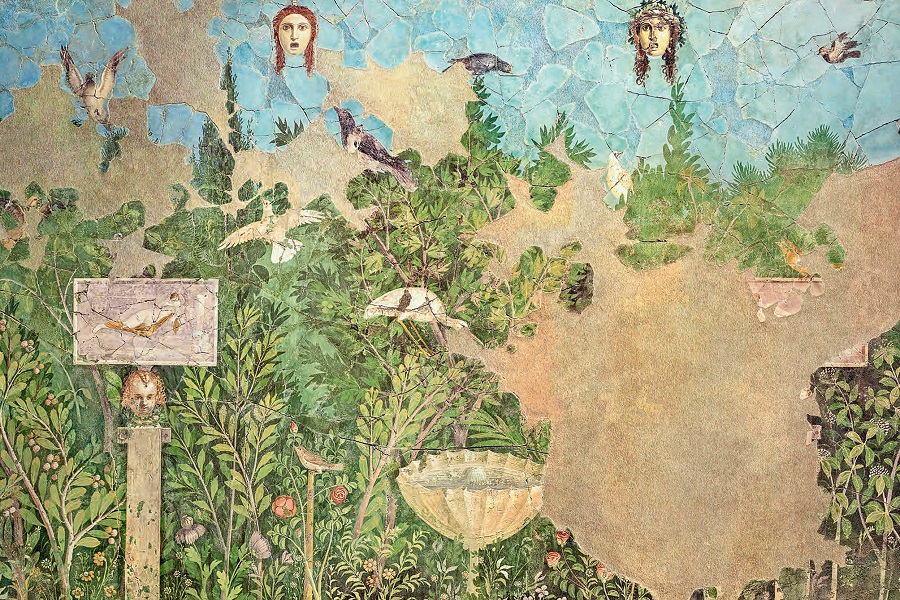Fresco of a garden scene, painted plaster 1st century CE, excavated from the House of the Golden Bracelet in 1975
Visual Arts / Pompeii: Inside a Lost City. At the National Museum of Australia, until May 4. Reviewed by KERRY- ANNE COUSINS.
Pompeii: Inside a Lost City uses cutting-edge technology to introduce the visitor to this ancient city and the lives of its inhabitants.
Pompeii has always exuded allure not only for its initial bounty of priceless antiquities that captivated antiquarians and others in the 18th and 19th centuries but also as a city caught in time, providing a view of life as it was lived in 79 CE when Mount Vesuvius erupted.
Without the eruption of Mount Vesuvius Pompeii would have either decayed into ruins like other ancient cities or morphed into a modern city with its past well hidden under the foundations of modern buildings.
It is perhaps fitting therefore that Mount Vesuvius provides the dramatic highlight of this exhibition. What was it like to be in Pompeii when the mountain erupted emitting poisonous clouds of gas and ash that covered the city before the trails of hot volcanic material buried the habitations of its citizens along with temples, the forum, theatres and other public buildings?

The main axis of the exhibition, a 35-metre long corridor, represents the main corso in Pompeii. It is bounded by two-metre high walls and is peopled by projected silhouetted figures of the citizens of Pompeii going about their everyday lives.
This enables the visitor of today to walk among them. At regular intervals a sound and light drama is enacted as Mount Vesuvius “erupts” and the walls that line the corso appear to shake with the force of the blast as sound and light simulate the hail of hot ash and lapilli (rock fragments) that fell down on the inhabitants.
No-one is suggesting that this is the same as experiencing an actual volcanic eruption, but there is enough drama to provide a glimpse of what it could have been like in the eruption’s initial stages.
If done well, as in this exhibition, digital technology can create an immersive experience that can deepen our understanding and enjoyment giving us a context for the information provided by the objects displayed.
Digital technology is now ubiquitous in exhibition design. Among the first landmark exhibitions that used sound and light to dramatic intent was the Destruction of the Country House at the Victoria & Albert Museum in London in 1974. The sounds of crashing wrecking balls and collapsing walls were accompanied by the images of demolished country houses.
Now in contemporary exhibitions dinosaurs and other prehistoric creatures come to life, ancient cities rise again, Chinese scrolls unroll and their figures in royal processions move stately by on large screens.
However the curators of this exhibition from Parco Archeologico di Pompei and the National Museum of Australia have recognised that, in addition to this theatre, visitors to historical exhibitions still want to see artefacts and objects that connect them directly with the past.
The exhibition has catered for this with a collection of everyday items found at Pompeii, including some from recent archaeological digs thoughtfully curated to provide a tangible insight into the everyday life of Pompeii’s citizens. There are displays of domestic ware, jewellery, cosmetics, as well as large statues. One delightful first century bronze jug from the House of Leda and the Swan has the figure of a man bent over as its handle looking into its interior.
Among the highlights of the exhibition are the wall decorations. The fresco of a garden scene with its rich and luscious vegetation inhabited by lovingly painted birds and the nymphaeum (water feature) of mosaics and shells both from the House of the Golden Bracelet are examples of the richness and sophistication of the decorative arts at Pompeii.
This is an exhibition that appeals on many levels giving visitors a dramatic immersive experience through digital technology. It also caters to those of us who wish to know more about Pompeii and its history as well as engaging with the actual objects that provide a poignant record of the past lives of its citizens.
Who can be trusted?
In a world of spin and confusion, there’s never been a more important time to support independent journalism in Canberra.
If you trust our work online and want to enforce the power of independent voices, I invite you to make a small contribution.
Every dollar of support is invested back into our journalism to help keep citynews.com.au strong and free.
Thank you,
Ian Meikle, editor






